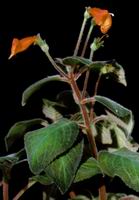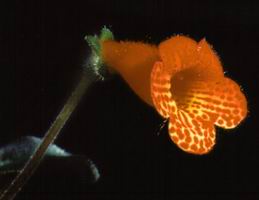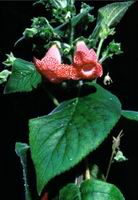

Cult. BG Vienna, phot. A. Weber (1980)
Full name and orig. publication: Kohleria Regel, Ind. Sem. Hort. Bot. Turic. [4]. 1847, reimp. Flora 31: 250 (1848).
Etymology: Named after Michael Kohler, teacher of Natural History at Zurich, Switzerland.
Synonyms: Isoloma (Benth.) Decne. (1848), non J.Smith (1841), Gesneria Mart. sect. Isoloma Benth. (1846), Tydaea Decne. (1848), Giesleria Regel (1849), Sciadocalyx Regel (1853), Brachyloma Hanst. (1854), Calycostemma Hanst. (1859), Cryptoloma Hanst. (1859), Kohleria Regel (1851), non Regel (1847), Synepileana Baill. (1888).
Infrafamilial position: Gesnerioid Gesneriaceae (Gesnerioideae) - Gloxinieae.
Description: Terrestrial, perennial herbs or subshrubs with scaly rhizomes. Stem usually erect, sometimes decumbent, terete. Leaves opposite or in whorls of 3-4, ± isophyllous, pilose or hirsute, petiolate. Inflorescences from leaf or bract axils, in few-flowered, fasciculate to umbellate cymes, or flowers solitary. Sepals erect or recurved, equalling or longer than the floral tube. Corolla somewhat zygomorphic, red or greenish; tube usually somewhat inflated or ventricose or campanulate above a narrow base, hirsute outside; limb bilabiate or regular, usually spotted or striped. Stamens 4, adnate to base of corolla tube; anthers at first coherent, later often becoming free; thecae dehiscent by longitudinal slits. Nectary deeply lobate or of 5 separate glands, the two dorsal ones usually united. Ovary more than half inferior; stigma bilobed. Fruit a dry capsule, dehiscing into 2 valves, apex conical or rostrate.
Chromosome number: 2n = 26.
Species number: 17.
Species names (incl. publication and synonyms): See Skog, L.E. & J.K. Boggan. 2005: World checklist of Gesneriaceae: http://persoon.si.edu/Gesneriaceae/Checklist.
Type species: Kohleria hirsuta (Kunth) Regel
Distribution: Western Cordillera from Peru to Mexico, Venezuela, Trinidad, the Guianas. The centre of diversity in Colombia.
Ecology: Growing in sun-exposed margins or glens of rain forest, also in secondary habitats.
Notes: Pollination syndromes include ornitho-, melitto-/euglosso- and chiropterophily. Some species are in cultivation, representing fine green-house ornamentals with spectacular flowers. Recently, based on molecular evidence, the two species of Capanea have been included in Kohleria (Roalson et. al 2005a,b). The plant well known under Capanea grandiflora (Kunth) Decne becomes Kohleria tigridia (J.H.Ohlendorff) Roalson & Boggan, Capanea affinis Fritsch Kohleria affinis (Fritsch) Roalson & Boggan. The first gives a perfect example of a bat-pollinated flower, the second seems to be, like many Kohleria species, ornithophilous.
Selected references: Wiehler, Selbyana 6: 168 (1983); Kvist & Skog, Smiths. Contrib. Bot. 79: 1-80 (1992), rev.; Morton, Baileya 15: 61-78 (1967), reg. rev. (Mexico); Skog, Ann. Missouri Bot. Gard. 65: 935-942 (1979), reg. rev (Panama); Feuillet & Steyermark, Fl. Venezuel. Guayana 5 (1999), reg. rev. (Panama); Skog, Monogr. Syst. Bot. Missouri Bot. Gard. 85: 1114-1128 (2001), reg. rev. (Nicaragua); Roalson, Boggan, Skog, Zimmer, Taxon 54(2): 389-410 (2005a), molec. syst.; Roalson, Boggan, Skog, Selbyana 25(2): 225-238 (2005b), tax.
Bibliography: See Skog, L.E. & J.K. Boggan. 2005. Bibliography of the Gesneriaceae. 2nd edition: http://persoon.si.edu/Gesneriaceae/Bibliography.
Illustrations:
 |
 |
Kohleria amabilis (Planch. & Linden) Fritsch [= K. bogotensis
(Nichols.) Fritsch]
Cult. BG Vienna, phot. A. Weber (1980) |
 |
Kohleria hybr.
Cult. BG Vienna, phot. A. Weber (1980) |
 |
Kohleria allenii Standley & L.O.Williams
Costa Rica, Bosque Esquinas, phot. A.Weber (1997) |
last modified: 2007-07-13